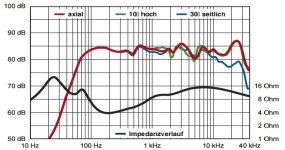Duke
New member
Duke L manufacturers speakers.
Yes, and unfortunately that means my perspective is likely to be skewed... I tend to mostly look for the role speakers might play in this or that problem. I'm kinda like the guy whose only tool is a hammer, so every problem looks like a nail.
Duke, do you think room EQ would help? Many of the box speakers that I have looked at generally cross over in the 2.5K Hz range. Do you think the problem you described above would be a problem with other speaker brands that x-over at that frequency?
This is just my opinion:
I'd never want to use room EQ north of 200 Hz. If you do use any EQ north of 200 Hz, I'd strongly suggest doing the exact same thing to both speakers, rather than EQing them independently (which is part of what I take to be implied by the term "room EQ"). Don't screw up the first-arrival sound for the sake of what an ungated omnidirectional microphone is telling you.
That being said, it's probably possible to come up with a gentle "compromise" curve that introduces some on-axis dippage at the lower end of the tweeter's range. Many designers do that in their passive crossovers, but it still doesn't fix the discrepancy between the direct and reverberant sound in that region, which becomes more pronounced as the midwoofer cone becomes bigger and/or stiffer. Imo if this is indeed what's going on, it would be an acoustic problem that calls for an acoustic solution, and that has to happen at the speaker design stage; it really can't be fixed via EQ'd after the fact.
One of the best stand-mount speakers I can recall was the sadly-discontinued Cliffhanger Bulldog. It was a three-way in a league where just about everything else was a two-way. The fairly large dome midrange in between the woofer and tweeter gave a smoother off-axis response than most two-ways, which imo matters. Or you might look at two-ways that use a smooth shallow waveguide around the tweeter, which reduces the radiation pattern discrepancy in the crossover region. These are becoming more widely used. In my experience, beware of "stepped" (as opposed to smooth-sided) waveguides, as they're using diffraction to get a more uniform radiation pattern, and imo that creates more problems than it solves. The devil is in the details.
Excellent advice, Duke!
Thank you Jim! That means a lot coming from you.

